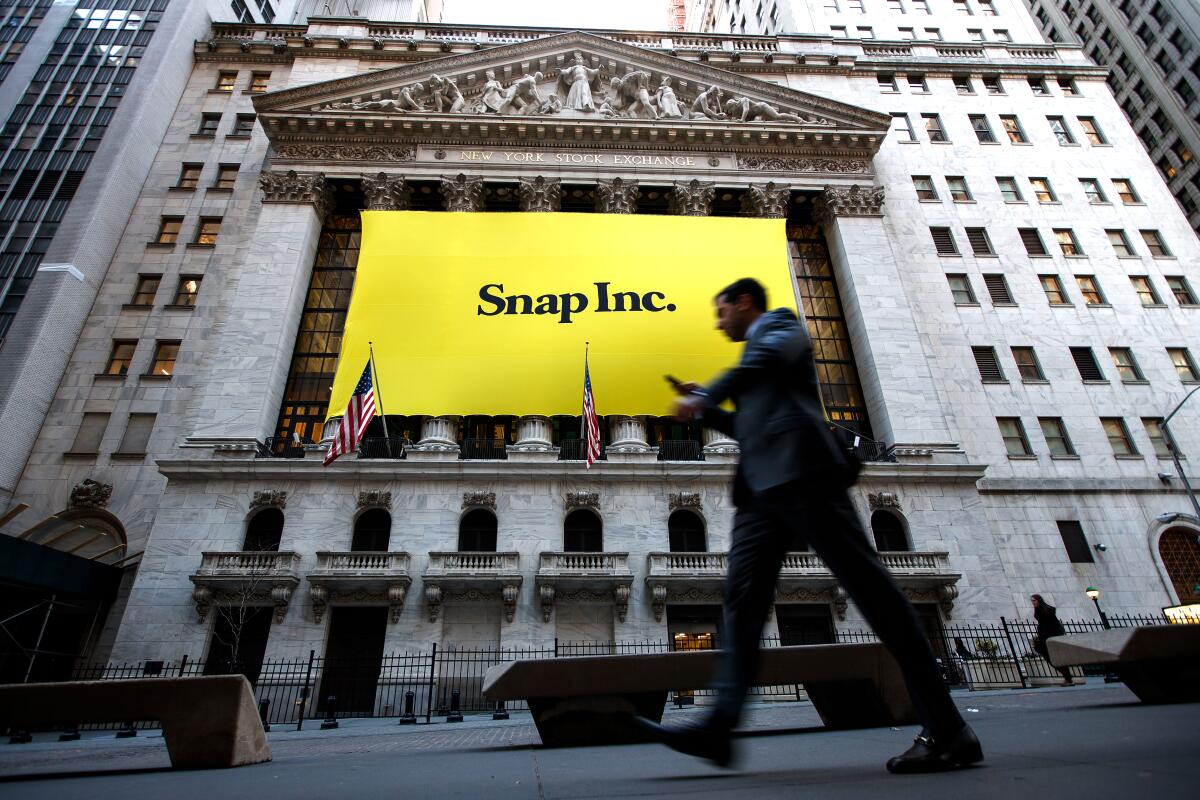Snap shares see biggest drop in a year after holiday sales disappoint

- Share via
Snap Inc. plunged by the most in more than a year after the Snapchat app owner reported lower-than-projected revenue over the peak holiday season, disappointing investors just a week after much-larger rival Meta Platforms Inc. posted its best sales growth in two years.
Revenue rose 5% to $1.36 billion in the fourth quarter, missing the $1.38 billion average of analysts’ estimates. For the full year, growth was flat, “reflecting a challenging operating environment,” the Santa Monica-based company said in a letter to shareholders on Tuesday.
Chief Executive Evan Spiegel has been leading the company through a broad restructuring over the past two years, cutting jobs and ending projects that don’t boost revenue or user growth. On Monday, Snap said it’s reducing its workforce by another 10% this year, an effort that it said would reduce hierarchy and promote in-person collaboration.
Despite layoffs, Snap projected a loss in adjusted earnings before interest, tax, depreciation and amortization of $55 million to $95 million in the current period, far bigger than the $33 million analysts’ were expecting. Shares were down as much as 32% in New York at $11.82, marking the biggest intraday decline since July 22, 2022.
Snap and Meta were badly affected by changes Apple Inc. made in 2021 to its privacy settings that made it harder for advertisers to track iPhone users. While Snap is struggling to recovery, Meta has bounced back, posting a 25% gain in sales in the fourth quarter. Snap has overhauled its core business to improve ad targeting and measuring its effectiveness, while also increasing its direct-response advertising offerings.
In a letter to shareholders, the company said it was “encouraged by the progress we are making with our ad platform,” and improved results for some advertising partners, but acknowledged that the conflict in the Middle East was a “headwind,” knocking about two percentage points off of growth in the fourth quarter.
Snap has tried adding new revenue streams to varying degrees of success. Its subscription offering, Snapchat+, has already amassed 7 million paying users with an annualized revenue run rate of $249 million — a unique feat among social media companies that have mostly failed to monetize subscribers. But its efforts to build augmented reality offerings for retailers was deemed too complex and shuttered last year.
Snapchat had 414 million daily active users in the fourth quarter, up 10% from the same period last year. Almost half of those are in established markets like North America and Europe — regions the company says it will now prioritize. It’s a notable pivot for Snap, which has spent years committing resources to building support for Android phones in emerging markets.
“We are shifting more of our focus toward user growth and deepening engagement in our most highly monetizable geographies,” Spiegel said in the letter. “Focusing on these initiatives will help us increase daily active usage of Snapchat, deepen content engagement, improve performance for advertisers, and ultimately accelerate revenue growth and drive increased free cash flow.”
More than 800 million people use the app globally every month, the company said.Snap projected revenue of $1.10 billion to $1.14 billion in the first quarter, up as much as 15% from a year earlier. The pace of growth is in line with analysts’ average estimates, according to data compiled by Bloomberg.
In the fourth quarter, Snap posted a net loss of $248.7 million, compared with a loss of $287.6 million a year earlier and less than the $287-million average analyst estimate. Earnings per share were 8 cents, compared with analyst estimates of 6 cents. The company will incur costs between $55 million and $75 million related to layoffs, the majority of which will be spent in the first quarter.
More to Read
Inside the business of entertainment
The Wide Shot brings you news, analysis and insights on everything from streaming wars to production — and what it all means for the future.
You may occasionally receive promotional content from the Los Angeles Times.










